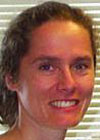 |
|
|
| Author |
Message |
Amy_Clapp

Joined: 23 Mar 2004
Posts: 84

|
 Posted:
Mon Jun 07, 2004 7:50 am Posted:
Mon Jun 07, 2004 7:50 am |
  |
June 5, 2004
Well, we got out on the boat today and did some of our major sampling-it was great! However, we did start the day with our regular sampling down at the shores of the Lena. The temperature of the water seems to be increasing rather quickly as it was already over a degree higher than it was yesterday.
As soon as we got to the boat, we began to set up our lab. Of course we don’t have the most ideal lab situation to do a lot of the sampling, but we try to make it as clean as possible. First of all we lay out a garbage bag instead of working right on the table, and we also not only wear gloves but change them really often so that we keep clean. Every time you touch something, like the door or the clipboard, your hands are dirty again, so needless to say we went through a lot of gloves. This was a new mindset for me because I hadn’t ever thought that a tube could get contaminated by just sitting on a table.

Another really important part about today was recording what we were doing and everything that happened along the way. At each station that we went to we recorded depth, temperature (from two different thermometers), latitude and longitude, and pH. It was also important to make sure to write down notes about anything unusual that may have happened or if we did not follow the procedure exactly.

So, anyway, the first part of the trip was setting up the lab and getting out to the sampling site. The captain did a great job, especially because there were still some pretty good sized chunks of ice that he skillfully avoided. The ideal site is a straight stretch of river without anything (like little islands in it) that is relatively narrow but still deep. The site that we went to was about five kilometers (3 miles) out from Zhigansk. It was neat to see the village from the water. This photo shows our shore sampling site from the water. We sampled just to the left of the pile of rocks with the stairs on the right.

We went to five different spots on one stretch of the river to do the sampling. Basically, we try to draw a straight line across the river from one shore to the other and then go to the middle of the river first and take a sample, then move as close to one shore as we can to get the second sample and slowly work our way over to the other shore taking three more samples.
Once we got to the first site, it took a few minutes to get the D-96 set up and ready to go. The D-96 is a pretty heavy, fragile, and expensive piece of equipment. It weighs about 130 pounds and the tail can easily be broken. How it works is that one of the scientists puts a Teflon bag in a tray and then attaches the bag to the nozzle of the D-96 with a Velcro strap. The tray is then attached to the rest of the D-96 and lowered into the water using the winch. Max or Sasha had to figure out, using trial and error, just how fast or slow to drop the D-96 so that the bag gets filled up while it is being dropped. They use a motor that brings it up really quickly so that no additional water is collected on the way up. Max figured this speed out today—he dropped it about three meters every 15 seconds. At first, he kept dropping it slower and slower, but it still only came up ˝ full. He finally decided to put a larger nozzle on which then allowed the bag to fill during the drop (the nozzle is the piece on the front of the D-96 where the water goes in).

After Max and Sasha figured out the timing of dropping the D-96, we collected one bag of water in the Teflon bag and put it in the churn (I’ll get to what that is later), and then we collected another bag of water by dropping the D-96 again and poured the water right from the Teflon bag into six different sampling bottles that were all labeled and ready to go (Max prepared all the bottles in Woods Hole and shipped them out a month or so ago). The samples that we collected from this first drop included getting a pH and temperature reading (this would be from the depth of water, not the surface), a trace elements sample (this sample will be used for scientists to find elements that they can use to trace where the water came from and what happens to it when it gets to the ocean). We collected a sample to measure 14C-DOC (dissolved organic carbon) which will allow scientists to figure out how old the carbon (an element) is which may give information about how the earth is changing (if old carbon has been released into the river water, it may indicate that ground that has been permanently frozen for a long time, has started to melt). Depending on the DOC composition, it could also be used as another tracer for when the water leaves the Lena. Bottles four and five are other samples that scientists can try and identify levels of certain elements that can be used to trace the water when it leaves the Lena. Bottle six is collected to preserve the phytoplankton (tiny plant organisms). However, in order to do this, you need to apply a solution called Lugol’s solution but we were not able to bring that with us on the plane, so we were not able to do this sample.

Station three definitely took the longest amount of time. After we were done with that, we basically just moved to each of the other sampling stations, and dropped the D-96 using the same speed as was used at the first station (so the bag shouldn’t fill up completely, since the depth is smaller). Once the D-96 is retrieved the water is dropped carefully into the churn. After we had hit the four remaining stations, we were ready to start processing the remaining samples.
So, the churn is what is used to collect all the different water from the different sites. You can see the churn in the picture where Max is filtering the bacteria—it is the white plastic bucket with the pole sticking up through it. The idea is to get water that is representative of the whole river, not just one small part of the river. Once the water is collected into the churn, a tube is put into the churn and it is attached to a pump that creates a suction pressure to get the water from the churn into the sample bottles. From the churn we processed about 20 more bottles, most of which were bottles that were going to be analyzed for different chemical compounds so again scientists can get some indications as to where this water has come from and what happens to it after it leaves the Lena.

There was another sample, which required some extra processing which was sort of neat. We did a microbial community sample, which will be analyzed to find out what sorts of bacteria are living in the water using their DNA. Using these samples, scientists can compare the types of bacteria living in this water and compare them to the water of the other rivers and even this river over time. Believe it or not, these bacteria have the potential of being tracers too. This means that they maybe able to follow where these bacteria go when the water leaves the Lena to get indications of where the river water goes when it hits the ocean.
Getting this sample required some extra steps. First we had to filter the water through this tiny little filter which collected all the particulates including all the bacteria. Then we injected the filter with a buffer solution which helps preserve the DNA. When this sample goes back to the lab, the scientist will do a procedure that creates lots of copies of the DNA of the bacteria. He will put the DNA on a gel, which separates out the bacteria so that he will be able to determine the different types of bacteria. Pretty neat!


So, once the churn water was all processed into different sample bottles, it was all put into a cooler.

All the samples are either refrigerated or frozen. So once we got back to shore we separated out those that needed to get frozen and those that needed to be refrigerated. We got back to the lodge and had to filter one more 20 liter jug of water and we had to complete our documentation then our day was done. Of course, I don’t have any experience with having ever done this before, but Max was very pleased with how smoothly everything went.
 |
|
|
    |
 |
|
|
|
View next topic
View previous topic
You cannot post new topics in this forum
You cannot reply to topics in this forum
You cannot edit your posts in this forum
You cannot delete your posts in this forum
You cannot vote in polls in this forum
You cannot attach files in this forum
You can download files in this forum
|
Powered by phpBB 2.0.11
© 2001, 2002 phpBB Group :: FI Theme ::
All times are GMT
| |
